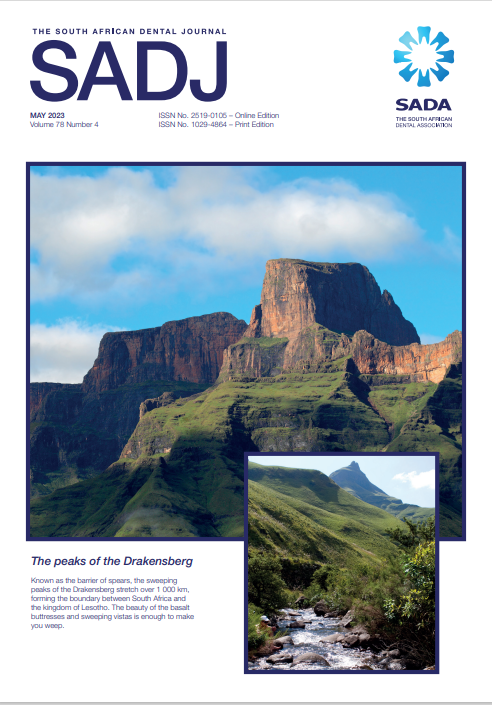Effect of separated instruments on periapical pH using calcium hydroxide as an intracanal medicament in curved root canals
Separated instruments and pH
DOI:
https://doi.org/10.17159/sadj.v78i04.15434Keywords:
separated instrument, Calcium Hydroxide, curved root canal, pH, Intracanal MedicamentsAbstract
Objective: To evaluate the effect of intracanal separated instruments with different lengths on periapical pH levels using calcium hydroxide (CH) as an intracanal medicament in curved root canals.
Materials and Methods: 120 teeth (root canal curvature >25˚) were divided into six groups following the root canal preparation. In Group 1, 2 mm and in Group 2, 4 mm NiTi instruments were separated in the apical portion of the root canals and CH paste was applied. In Groups 3 and 4, no separated instrument but CH was applied. In Groups 5 and 6, neither a separated instrument nor CH. The samples were placed inside a glass tubes with distilled water. pH of this distilled water was measured at different time-points.
Results: At all-time points, pH values between the experimental groups were similar except at 1-day (Group 1 < Group 2, P<0.05). At the 2-day and 30-day time points, Group 3 showed higher pH values than Group 1 (P<0.05). At 7-day and 14-day points, pH values were similar.
Conclusions: The presence of a separated instrument with different lengths in curved root canals did not have a significant effect on the pH increase caused by CH used as an intracanal medicament.
Downloads
References
Panitvisai P, Parunnit P, Sathorn C, et al. Impact of a retained instrument on treatment outcome: a systematic review and meta-analysis. J Endod 2010;36:775-780.
Suter B, Lussi A, Sequeira P. Probability of removing fractured instruments from root canals. Int Endod J 2005;38:112-123.
Parashos P, Messer H. Questionnaire survey on the use of rotary nickel–titanium endodontic instruments by Australian dentists. Int Endod J 2004;37:249-259.
Iqbal MK, Kohli MR, Kim JS. A retrospective clinical study of incidence of root canal instrument separation in an endodontics graduate program: a PennEndo database study. J Endod 2006;32:1048-1052.
Tzanetakis GN, Kontakiotis EG, Maurikou DV, et al. Prevalence and management of instrument fracture in the postgraduate endodontic program at the Dental School of Athens: a five-year retrospective clinical study. J Endod 2008;34:675-678.
Ankrum MT, Hartwell GR, Truitt JE. K3 Endo, ProTaper, and ProFile systems: breakage and distortion in severely curved roots of molars. J Endod 2004;30:234-237.
Ward JR, Parashos P, Messer HH. Evaluation of an ultrasonic technique to remove fractured rotary nickel-titanium endodontic instruments from root canals: an experimental study. J Endod 2003;29:756-763.
Lopes HP, Moreira EJL, Elias CN, et al. Cyclic fatigue of ProTaper instruments. J Endod 2007;33:55-57.
Madarati AA, Hunter MJ, Dummer PM. Management of intracanal separated instruments. J Endod 2013;39:569-581.
Ungerechts C, Bårdsen A, Fristad I. Instrument fracture in root canals‐where, why, when and what? A study from a student clinic. Int Endod J 2014;47:183-190.
Spili P, Parashos P, Messer HH. The impact of instrument fracture on outcome of endodontic treatment. J Endod 2005;31:845-850.
Peters L, Van Winkelhoff AJ, Buijs J, et al. Effects of instrumentation, irrigation and dressing with calcium hydroxide on infection in pulpless teeth with periapical bone lesions. Int Endod J 2002;35:13-21.
Stuart KG, Miller CH, Brown CE, et al. The comparative antimicrobial effect of calcium hydroxide. Oral Surg Oral Med Oral Pathol 1991;72:101-104.
Haapasalo H, Siren E, Waltimo T, et al. Inactivation of local root canal medicaments by dentine: an in vitro study. Int Endod J 2000;33:126-131.
Nerwich A, Figdor D, Messer HH. pH changes in root dentin over a 4-week period following root canal dressing with calcium hydroxide. J Endod 1993;19:302-306.
Canakci B, Sungur R, Er Ö. Do separated instruments affect pH levels when using calcium hydroxide as intracanal dressing? Niger J Clin Pract 2019;22:1236.
Vertucci FJ. Root canal anatomy of the human permanent teeth. Oral Surg Oral Med Oral Pathol Oral Radiol 1984;58:589-599.
Schneider SW. A comparison of canal preparations in straight and curved root canals. Oral Surg Oral Med Oral Pathol 1971;32:271-275.
Zmener O, Pameijer CH, Banegas G. An in vitro study of the pH of three calcium hydroxide dressing materials. Dent Traumatol 2007;23:21-25.
Hosoya N, Takahashi G, Arai T, et al. Calcium concentration and pH of the periapical environment after applying calcium hydroxide into root canals in vitro. J Endod 2001;27:343-346.
Grover C, Shetty N. Evaluation of calcium ion release and change in pH on combining calcium hydroxide with different vehicles. Contemp Clin Dent 2014;5:434.
Fuss Z, Rafaeloff R, Tagger M, et al. Intracanal pH changes of calcium hydroxide pastes exposed to carbon dioxide in vitro. J Endod 1996;22:362-364.
Schröder U. Effects of calcium hydroxide-containing pulp-capping agents on pulp cell migration, proliferation, and differentiation. J Dent Res 1985;64:541-548.
Chamberlain TM, Kirkpatrick TC, Rutledge RE. pH changes in external root surface cavities after calcium hydroxide is placed at 1, 3 and 5 mm short of the radiographic apex. Dent Traumatol 2009;25:470-474.
Cheung GS. Instrument fracture: mechanisms, removal of fragments, and clinical outcomes. End Topics 2007;16:1-26.
Dannemann M, Kucher M, Kirsch J, et al. An approach for a mathematical description of human root canals by means of elementary parameters. J Endod 2017;43:536-543.
Downloads
Published
Issue
Section
License
Copyright (c) 2023 Rezan Sungur Güzel, Burhan Çanakçı, Özgür Er, Esra Arılı Öztürk

This work is licensed under a Creative Commons Attribution-NonCommercial 4.0 International License.
How to Cite
Funding data
-
Trakya Üniversitesi
Grant numbers 2017/172






.png)